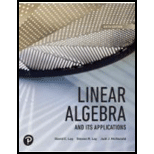
Exercises 31 and 32 reveal an important connection between linear independence and linear transformations and provide practice using the definition of linear dependence. Let V and W be
32. Suppose that T is a one-to-one transformation, so that an equation T(u) = T(v) always implies u = v. Show that if the set of images {T(v1),…,T(vp)} is linearly dependent, then {v1,..., vp} is linearly dependent. This fact shows that a one-to-one linear transformation maps a linearly independent set onto a linearly independent set (because in this case the set of images cannot be linearly dependent).
Want to see the full answer?
Check out a sample textbook solution
Chapter 4 Solutions
EBK LINEAR ALGEBRA AND ITS APPLICATIONS
Additional Math Textbook Solutions
Elementary & Intermediate Algebra
Calculus: Early Transcendentals (2nd Edition)
College Algebra (Collegiate Math)
Precalculus: Mathematics for Calculus (Standalone Book)
APPLIED STAT.IN BUS.+ECONOMICS
Elementary Algebra: Concepts and Applications (10th Edition)
- You are provided with three 2D data points, p1, p2 and p3. Solving A C = B for C provides youwith the coefficients of a natural cubic spline curve that interpolates these points.Additionally, you have been given A and B, but some elements are missing. Moreover, the last two rowsof A are entirely absent. Your task is to determine and fill in the missing elements. For the last two rows,enforce a zero tangent at the beginning (in p1) and a not-a-knot boundary condition in p2. The matricesA and B are given as follows:Explain how to find the entries of A and B . How would you adapt these matrices if the data pointswere 3D? What if your spline should go through five data points? How many “extra rows” would there thenbe (with “extra” meaning “in addition to securing C2-continuity”)?arrow_forwardWhich graph represents f(x) = √x-2+3?arrow_forwardPractice Assignment 5.6 Rational Functions M Practice Assig Practice Assignment 5.6 Rational Functions Score: 120/150 Answered: 12/15 Question 10 A Write an equation for the function graphed below 5 + 4 1 2 H + + -7 -6 -5 -4 -3 -2 -1 2 34567 | -2 ర y = Question Help: Video Message instructor Post to forum Submit Questionarrow_forward
- > co LO -6 -5 -4 4 do 3 3 2 1 Τ O 1 3 4 5 --6- -CO 6arrow_forwardx/x-2 + 3/x-4arrow_forwardQ1: A: Let M and N be two subspace of finite dimension linear space X, show that if M = N then dim M = dim N but the converse need not to be true. B: Let A and B two balanced subsets of a linear space X, show that whether An B and AUB are balanced sets or nor verly A:LeLM be a subset of a linear space X, show that M is a hyperplane of X iff there exists fe X'/[0] and a EF such that M = {x Ex/f(x) = = a}. B:Show that every two norms on finite dimension linear space are equivalent C: Let f be a linear function from a normed space X in to a normed space Y, show that continuous at x, EX iff for any sequence (x) in X converge to x, then the sequence (f(x)) converge to (f(x)) in Y.arrow_forward
- 2/26 Delta Math | Schoology X Unit 4: Importance of Education X Speech at the United Nations b x Book Thief Part 7 Summaries x + > CA Materials pdsd.schoology.com/external_tool/3157780380/launch ☆ MC Updates Grades Members BrainPOP Canva for Education DeltaMath Discovery Education FactCite Gale In Context: High Sc. Graw McGraw Hill K-12 SSO Draw a line representing the "rise" and a line representing the "run" of the line. State the slope of the line in simplest form. Click twice to plot each segment. Click a segment to delete it. 10 9 8 5 сл y Hill Nearpod 3 2 Newsela -10 -9 -8 -7 b -5 -4-3-2 -1 1 23 4 5 b 7 89 10 Scholastic Digital Mana. World Book Online Information Grading periods MP3: 2025-01-25-2025-03- 31, MP4: 2025-04-01-2025- 06-13 ← 2 M -> C % 95 54 # m e 4 7 巴 DELL A t y & * ) 7 8 9 . i L Feb 27 12:19 US + 11arrow_forwardLet & be linear map from as Pacex into aspace and {X1, X2, – 1— x3 basis for x show that f a one-to-one isf {f(x1), f (xx); — F (Kn) } linearly independent. மம் let M be a Proper sub space of aspace X then M is ahyper space iff for any text&M X=. C) let X be a linear space and fe X1{0} Show that is bjective or not and why? ***********arrow_forwardQ₁/(a) Let S and T be subsets of a vector space X over a field F such that SCT,show that whether (1) if S generate X then T generate X or not. (2) if T generate X then S generate X or not. (b) Let X be a vector space over a field F and A,B are subsets of X such that A is convex set and B is affine set, show that whether AnB is convex set or not, and if f be a function from X into a space Y then f(B) is an affine set or not. /(a) Let M and N be two hyperspaces of a space X write a condition to prove MUN is a hyperspace of X and condition to get that MUN is not hyperspace of X. Write with prove application n Panach theoremarrow_forward
 Elementary Linear Algebra (MindTap Course List)AlgebraISBN:9781305658004Author:Ron LarsonPublisher:Cengage Learning
Elementary Linear Algebra (MindTap Course List)AlgebraISBN:9781305658004Author:Ron LarsonPublisher:Cengage Learning Linear Algebra: A Modern IntroductionAlgebraISBN:9781285463247Author:David PoolePublisher:Cengage Learning
Linear Algebra: A Modern IntroductionAlgebraISBN:9781285463247Author:David PoolePublisher:Cengage Learning

